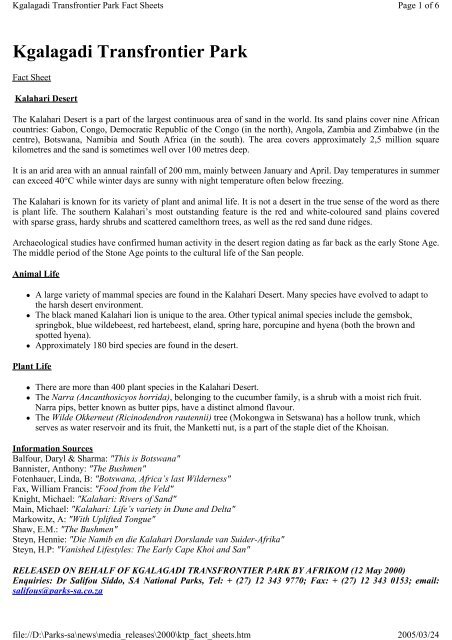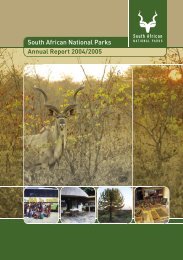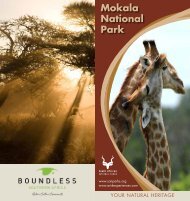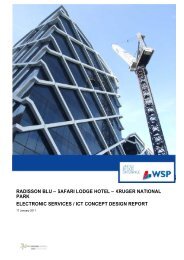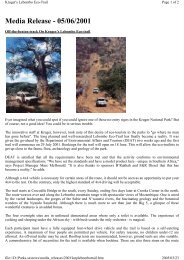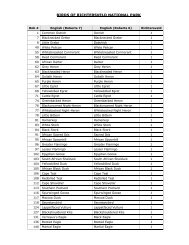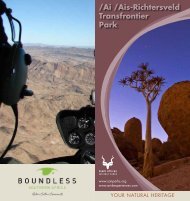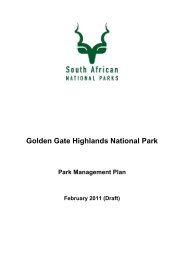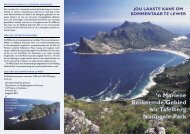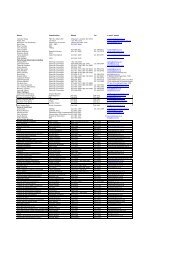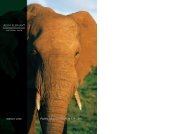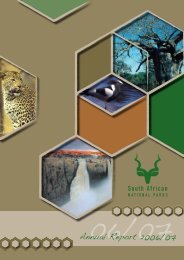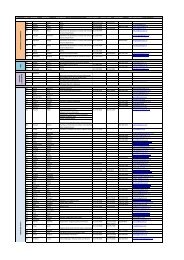Kgalagadi Transfrontier Park - Fact Sheets - SANParks
Kgalagadi Transfrontier Park - Fact Sheets - SANParks
Kgalagadi Transfrontier Park - Fact Sheets - SANParks
You also want an ePaper? Increase the reach of your titles
YUMPU automatically turns print PDFs into web optimized ePapers that Google loves.
<strong>Kgalagadi</strong> <strong>Transfrontier</strong> <strong>Park</strong> <strong>Fact</strong> <strong>Sheets</strong><br />
file://D:\<strong>Park</strong>s-sa\news\media_releases\2000\ktp_fact_sheets.htm<br />
Page 1 of 6<br />
2005/03/24<br />
<strong>Kgalagadi</strong> <strong>Transfrontier</strong> <strong>Park</strong><br />
<strong>Fact</strong> Sheet<br />
Kalahari Desert<br />
The Kalahari Desert is a part of the largest continuous area of sand in the world. Its sand plains cover nine African<br />
countries: Gabon, Congo, Democratic Republic of the Congo (in the north), Angola, Zambia and Zimbabwe (in the<br />
centre), Botswana, Namibia and South Africa (in the south). The area covers approximately 2,5 million square<br />
kilometres and the sand is sometimes well over 100 metres deep.<br />
It is an arid area with an annual rainfall of 200 mm, mainly between January and April. Day temperatures in summer<br />
can exceed 40°C while winter days are sunny with night temperature often below freezing.<br />
The Kalahari is known for its variety of plant and animal life. It is not a desert in the true sense of the word as there<br />
is plant life. The southern Kalahari’s most outstanding feature is the red and white-coloured sand plains covered<br />
with sparse grass, hardy shrubs and scattered camelthorn trees, as well as the red sand dune ridges.<br />
Archaeological studies have confirmed human activity in the desert region dating as far back as the early Stone Age.<br />
The middle period of the Stone Age points to the cultural life of the San people.<br />
Animal Life<br />
• A large variety of mammal species are found in the Kalahari Desert. Many species have evolved to adapt to<br />
the harsh desert environment.<br />
• The black maned Kalahari lion is unique to the area. Other typical animal species include the gemsbok,<br />
springbok, blue wildebeest, red hartebeest, eland, spring hare, porcupine and hyena (both the brown and<br />
spotted hyena).<br />
• Approximately 180 bird species are found in the desert.<br />
Plant Life<br />
• There are more than 400 plant species in the Kalahari Desert.<br />
• The Narra (Ancanthosicyos horrida), belonging to the cucumber family, is a shrub with a moist rich fruit.<br />
Narra pips, better known as butter pips, have a distinct almond flavour.<br />
• The Wilde Okkerneut (Ricinodendron rautennii) tree (Mokongwa in Setswana) has a hollow trunk, which<br />
serves as water reservoir and its fruit, the Manketti nut, is a part of the staple diet of the Khoisan.<br />
Information Sources<br />
Balfour, Daryl & Sharma: "This is Botswana"<br />
Bannister, Anthony: "The Bushmen"<br />
Fotenhauer, Linda, B: "Botswana, Africa’s last Wilderness"<br />
Fax, William Francis: "Food from the Veld"<br />
Knight, Michael: "Kalahari: Rivers of Sand"<br />
Main, Michael: "Kalahari: Life’s variety in Dune and Delta"<br />
Markowitz, A: "With Uplifted Tongue"<br />
Shaw, E.M.: "The Bushmen"<br />
Steyn, Hennie: "Die Namib en die Kalahari Dorslande van Suider-Afrika"<br />
Steyn, H.P: "Vanished Lifestyles: The Early Cape Khoi and San"<br />
RELEASED ON BEHALF OF KGALAGADI TRANSFRONTIER PARK BY AFRIKOM (12 May 2000)<br />
Enquiries: Dr Salifou Siddo, SA National <strong>Park</strong>s, Tel: + (27) 12 343 9770; Fax: + (27) 12 343 0153; email:<br />
salifous@parks-sa.co.za
<strong>Kgalagadi</strong> <strong>Transfrontier</strong> <strong>Park</strong> <strong>Fact</strong> <strong>Sheets</strong><br />
file://D:\<strong>Park</strong>s-sa\news\media_releases\2000\ktp_fact_sheets.htm<br />
Page 2 of 6<br />
2005/03/24<br />
Mr Jan Broekhuis, DWNP, Botswana, Tel: + (267) 371405; Fax: + (267) 312354; email: dwnp@gov.bw<br />
THE GEMSBOK (ORYX) SCULPTURE<br />
F A C T S H E E T<br />
• Life-size bronze sculpture of two running gemsbok (oryx). Weight: 450 kg.<br />
• Took six months to complete. (Sculpting original wax, moulds, casting and bronze finishing.)<br />
• Artist worked from photos, liaised with taxidermists and did anatomical studies at Onderstepoort.<br />
• Certain skeleton parts were used. (An actual skull was used in the original wax sculpture.)<br />
THE SYMBOLISM<br />
• The sculpture depicts gemsbok on the run, with only two feet touching the ground. This represents the<br />
freedom brought about by the establishment of a transfrontier park where game can roam without physical<br />
restrictions over large expanses of land.<br />
THE ARTIST<br />
• Based in Pretoria, South Africa, Alan Ainslie’s career as a wildlife artist commenced in 1984 when he was<br />
commissioned to produce wildlife paintings for a calendar.<br />
• Ainslie held his first solo exhibition in 1987.<br />
• He has participated in numerous international wildlife exhibitions together with the works of Raymond<br />
Harris-Ching (New Zealand), Keith Joubert (SA) and Paul Bosman (USA).<br />
• The dominant factor in his work is realism, enhanced by poses that are subtle and true to life.<br />
• Sculpting is a recent addition to his ability to capture and portray the creatures of the wild.<br />
OTHER SCULPTURES<br />
• Twelve miniature bronzes of a buffalo for the 1998 One Million Dollar Golf Challenge.<br />
• ‘Mafunyane’ the elephant for the new Hillside aluminium plant in Maputo.<br />
• Only other life-size bronze sculpture is that of a leopard.<br />
• Currently tendering for a life-size horse and rider for Mauritius.<br />
THE ARTIST ON HIS WORK<br />
"To portray the characteristics of a wild animal in two-dimensional way through painting, is a challenge. To<br />
capture these characteristics in a three-dimensional form through sculpting, remains for me the ultimate expression<br />
of art."<br />
RELEASED ON BEHALF OF KGALAGADI TRANSFRONTIER PARK BY AFRIKOM (12 May 2000)<br />
Enquiries: Alan Ainslie, Sculptor, Pretoria, Tel: (012) 991-2565<br />
Frikkie Odendaal, Afrikom, Cape Town, Tel: (021) 423-7263<br />
F A C T S H E E T<br />
Historic Development of the <strong>Kgalagadi</strong> <strong>Transfrontier</strong> <strong>Park</strong><br />
• The <strong>Kgalagadi</strong> <strong>Transfrontier</strong> <strong>Park</strong> (KTP) has been in de facto existence for more than half a century. It has<br />
enabled Botswana and South Africa to manage this vast area, located in the southern Kalahari, as a single<br />
ecological unit. In recognition of this agreement, no barriers to wildlife movement exist along the international<br />
boundary that separates the 9,591 km 2 Kalahari Gemsbok National <strong>Park</strong> in the Republic of South Africa and
<strong>Kgalagadi</strong> <strong>Transfrontier</strong> <strong>Park</strong> <strong>Fact</strong> <strong>Sheets</strong><br />
file://D:\<strong>Park</strong>s-sa\news\media_releases\2000\ktp_fact_sheets.htm<br />
Page 3 of 6<br />
2005/03/24<br />
the 28,400 km² Gemsbok National <strong>Park</strong> in Botswana.<br />
• Since June 1992, a joint management committee comprised of representatives from the conservation<br />
authorities of South Africa and Botswana has been working to formalise the de facto agreement and establish<br />
the KTP. This is the first formally declared <strong>Transfrontier</strong> <strong>Park</strong> in Africa and it will hopefully serve as a model<br />
for conservation in the 21 st century.<br />
• Plans to formalise the joint development and management of the two contiguous parks were proposed in 1989<br />
following a fact-finding study on tourism developments in Southern Africa, commissioned by the Permanent<br />
Secretary of the Ministry of Commerce and Industry in Botswana. As a result, in May 1991, the Department<br />
of Wildlife and National <strong>Park</strong>s of Botswana received the mandate to consult further on the matter with South<br />
African National <strong>Park</strong>s. Initial meetings between the two conservation agencies led to the establishment of the<br />
<strong>Transfrontier</strong> Management Committee (TMC).<br />
• The TMC has been responsible for the co-ordination of the management of the two parks and has worked<br />
towards the formal establishment of the <strong>Transfrontier</strong> <strong>Park</strong>. The management plan for the area has been<br />
drafted by the TMC and the policies and actions necessary to maintain the cohesiveness and unity of the<br />
<strong>Transfrontier</strong> <strong>Park</strong> have been agreed upon. It provides the policies for joint management of the area as a single<br />
ecological unit and serves as a basis for the promotion of tourism. This plan is now being implemented and<br />
will be regularly revised and updated.<br />
• Tourists will be able to move freely within the park and the TMC is producing a unified set of regulations to<br />
govern visitor behaviour throughout the <strong>Transfrontier</strong> <strong>Park</strong>. The two parks will operate autonomously in the<br />
running of their own internal affairs and in the development of their own tourist facilities as agreed in the<br />
management plan. Both countries recognise the sovereign equality and territorial integrity of the other. It has<br />
been agreed that entrance fees will be pooled and shared equally by both countries but that other income (from<br />
accommodation, camping, etc) will be retained by the country that generates it.<br />
Joint Management Objectives<br />
The overall objectives of the management plan of the KTP are as follows:<br />
• To preserve the diversity of organisms indigenous to the southern Kalahari as functional elements of the<br />
ecosystem, with predators receiving priority<br />
• To maintain those ecological processes which characterise the Kalahari ecosystem<br />
• To provide facilities and opportunities for research and monitoring to advance understanding of the physical<br />
and biological processes of the Kalahari ecosystem<br />
• To provide educational and interpretative programmes for visitors to foster a better understanding and<br />
appreciation of the Kalahari ecosystem<br />
• To realise economic returns from tourism while safeguarding the ecological integrity and pristine wilderness<br />
of the Kalahari.<br />
RELEASED ON BEHALF OF KGALAGADI TRANSFRONTIER PARK BY AFRIKOM (12/5/2000)<br />
Enquiries:<br />
Dr Salifou Siddo, SANP, SA, Tel:: + (27) 12 343 9770; Fax: + (27) 12 343 0153;<br />
email: salifous@parks-sa.co.za<br />
Mr Jan Broekhuis, DWNP, Botswana, Tel: + (267) 371405; Fax: + (267) 312354;<br />
email: dwnp@gov.bw<br />
F A C T<br />
S H E E T<br />
Frequently Asked Questions
<strong>Kgalagadi</strong> <strong>Transfrontier</strong> <strong>Park</strong> <strong>Fact</strong> <strong>Sheets</strong><br />
file://D:\<strong>Park</strong>s-sa\news\media_releases\2000\ktp_fact_sheets.htm<br />
Page 4 of 6<br />
2005/03/24<br />
1. Where is the <strong>Kgalagadi</strong> <strong>Transfrontier</strong> <strong>Park</strong> (KTP) located?<br />
In the <strong>Kgalagadi</strong> District on the south western border of Botswana and the Northern Cape border of<br />
South Africa. Its main entrance is situated approximately 865 km south west of Gaborone and about 166<br />
km north of Upington.<br />
2. How does one get to the <strong>Park</strong>?<br />
From Upington on tarred road to the north.<br />
To get to the <strong>Park</strong> from Botswana travel from Gaborone on tarred road for about 550 km until Tsabong<br />
in <strong>Kgalagadi</strong> District. From Tsabong travel for about 310 km on gravel road. This road is negotiable by<br />
4 x 2 vehicles during the dry season and 4 x 4 vehicles during the wet season. An alternative route is to<br />
travel from Gaborone to Hukuntsi on tarred road for 565 km followed by approximately 130 km of sand<br />
road to Mabuasehube, which is negotiable by 4 x 4 vehicles only.<br />
3. What is its size?<br />
The combined land area of the KTP is about 38 000 km 2 , of which 28 400 km 2 lies in Botswana and 9<br />
600 km 2 in South Africa.<br />
4. Where can one get fuel on the way to the <strong>Park</strong>?<br />
There are petrol stations at the following places on the way to the <strong>Park</strong> (if travelling from Gaborone):<br />
Route 1: Gaborone, Jwaneng, Sekoma, Werda, Tsabong, Bokspits and Twee Rivieren<br />
Route 2: Gaborone, Jwaneng, Sekoma, Kang, Hukuntsi<br />
From the south (Upington) or south-east (Kuruman, Hotazel, Vanzylsrus, Askham) fuel is readily<br />
available.<br />
Fuel is available in the KTP at Twee Rivieren.<br />
5. What is the weather like?<br />
The region is arid, with an annual rainfall of about 200 mm, mainly between January and April. In<br />
summer temperatures may exceed 40 C. In winter days are sunny with night temperatures often below<br />
zero.<br />
6. When was the KTP commissioned?<br />
The Bilateral Agreement between Botswana and South Africa was signed on 7 th April 1999 and the<br />
<strong>Transfrontier</strong> <strong>Park</strong> was officially launched on 12 th May 2000.<br />
7. The KTP is made up of <strong>Park</strong>s from Botswana and South Africa: when were they established?<br />
Gemsbok National <strong>Park</strong> (Botswana) was established in 1938 and the Kalahari Gemsbok National <strong>Park</strong><br />
(South Africa) was established in 1931.<br />
8. What was the main motivation for its creation?
<strong>Kgalagadi</strong> <strong>Transfrontier</strong> <strong>Park</strong> <strong>Fact</strong> <strong>Sheets</strong><br />
file://D:\<strong>Park</strong>s-sa\news\media_releases\2000\ktp_fact_sheets.htm<br />
Page 5 of 6<br />
2005/03/24<br />
Through this joint venture, Botswana and South Africa are able to guarantee the long-term conservation<br />
of the valuable wildlife resources in the southern Kalahari, thus helping to maintain the integrity of the<br />
entire Kalahari ecosystem. Both countries will benefit from the pooling of expertise and experience in<br />
park management. The two countries will raise the international profile of this important conservation<br />
area through joint promotional campaigns, thereby enhancing its status and potential as a sought after<br />
tourist destination.<br />
9. What animals can be seen in the KTP?<br />
The KTP boasts Africa’s big wild cats - lion, cheetah, and leopard. Brown and spotted hyenas and many<br />
other desert-adapted species such as gemsbok, springbok, blue wildebeest, eland, red hartebeest,<br />
suricates and ostrich are also to be found in the area.<br />
10. What about accommodation facilities?<br />
There are three rest camps, namely Twee Rivieren, Mata Mata and Nossob, each featuring six-bed selfcatering<br />
cottages. Only the cottages at Twee Rivieren are air-conditioned.<br />
Camping facilities are available at Two Rivers, Rooiputs and Polentswa. These offer basic amenities<br />
such as ablution blocks and shade structures but at Polentswa campers are required to provide their own<br />
water. The Mabuasehube area also offers camping at seven sites, namely Mabuasehube Entrance,<br />
Monamodi, Lesholoago, Mpaathutlwa, Mabuasehube Pan, Khiding Pan, and Bosobogolo.<br />
11. Is it possible to travel from Two Rivers to Mabuasehube using the Wilderness Trail?<br />
Not yet, but Botswana’s Department of Wildlife and National <strong>Park</strong>s is planning to link the Nossob<br />
Valley to Mabuasehube with a new trail by 2001.<br />
12. Are tourists required to carry a passport between the two countries when in the park or are there customs<br />
and immigration points in the park?<br />
You do not need to take a passport to use the <strong>Transfrontier</strong> <strong>Park</strong>. You may enter from either country and<br />
enjoy all the facilities. However, you must return into the country from which you entered. There are<br />
plans to set up a common entry point with customs and immigration facilities so that tourists may enter<br />
from one country and exit through another but this facility will take a year or two be put in place.<br />
13. Is it possible to pay park fees by credit card?<br />
On the Botswana side, fees must be paid in Botswana Pula, but credit cards can be used on the South<br />
African side.<br />
14. Are tourists allowed to camp on South African side before going on the Wilderness Trail?<br />
Tourists are now permitted to travel to the <strong>Park</strong> and to stay on either side of the <strong>Park</strong>. However, it is still<br />
necessary to make separate bookings with reservations offices in the respective countries, for the<br />
periods to be spent in either country.<br />
For more information, please contact:<br />
BOTSWANA:<br />
Reservations Office, P.O. Box 131, Gaborone, Botswana. Tel: + 267 580774; Fax: + 267 580775; e-mail:<br />
dwnp@gov.bw<br />
SOUTH AFRICA:
<strong>Kgalagadi</strong> <strong>Transfrontier</strong> <strong>Park</strong> <strong>Fact</strong> <strong>Sheets</strong><br />
file://D:\<strong>Park</strong>s-sa\news\media_releases\2000\ktp_fact_sheets.htm<br />
Page 6 of 6<br />
2005/03/24<br />
Reservations Office, P.O. Box 787, Pretoria 0001, South Africa. Tel: + 27 12 343 1991; Fax: + 27 12 343 0905; e-<br />
mail: reservations@parks-sa.co.za<br />
[back] [top]


